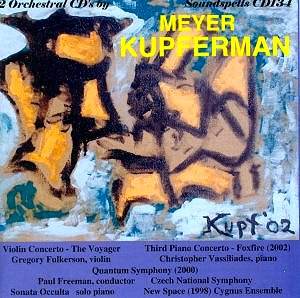Kupferman is of mixed emigré Romanian
and Russian parentage. He is entirely self-taught in composition.
Kupferman's father introduced him to many East European, Jewish
and gypsy melodies. In his teenage years he worked in jazz clubs
absorbing an idiom that surfaces from time to time in his compositions.
Kupferman was professor of composition at Sarah Lawrence College
from 1951 until his retirement in 1994. There are, as of 2002,
seven operas, twelve symphonies, nine ballets, seven string quartets,
ten concertos and hundreds of chamber works.
Kupferman's long nurtured interest in jazz has
fermented fruitfully with his concert music. In addition to the
Concerto for cello and jazz band there are - Sonata on Jazz
Elements, Tunnels of Love, Adjustable Tears and
Jazz String Quartet. There was a Jazz Symphony in
1988 recorded in 1990 by the Lithuanian National Symphony Orchestra
on Soundspells CD104.
The Voyager Violin Concerto owes
something of its existence to the composer happening upon one
of his old and tattered notebooks of violin ideas. Although none
of the old material was used Kupferman, while stuck in the creative
doldrums, took the idea of mixing old and new. The Concerto is
in three movements - slow-fast-slow. The soloist stands silent
before each then plays a cadenza-like ‘foreword’. These movements,
we are told, share the same nine-tone motif, the same lyric theme
and the same absorption in contemplation. Rather like the Cello
Concerto (VoxBox) this is a quintessentially romantic work (try
the middle movement) buttressed by
the composer's predilection for atonalism and anxiety. The more
agitated music proclaims an interest in the Polish 'modernism'
of Lutosławski and Penderecki. Gregory Fulkerson has recorded
previously with Louisville Edition. He is the soloist in
the Roy Harris Violin Concerto on Albany. The composer must have
been delighted with Fulkerson's totally committed approach, his
virtuosity both in display and in poignant eloquence. Schuman
meets Penderecki.
New Space is for oboe, violin
and guitar. This work was commissioned for the Raritan River Music
Festival. It was written just after sons were born to two of the
composer’s friends. The penetrating and confidently probing singing
of the oboe interacts with the busily garrulous violin and the
commentary of the guitar. Kupferman makes no attempt to make any
of these instruments do anything that is alien to their souls.
The guitar's role recalled for me the part played by the harp
in several of Kupferman's works where, usually in a ‘canyon’ of
sound, a sudden rhythmic or melodic effect seizes the moment in
a way that carries the music forward or holds time in its grasp
for eerie seconds.
The Foxfire Piano Concerto (his
third) is from 2002. Kupferman tells us that the piano is his
favourite instrument. He says that he has composed more works
for the piano than for any other instrument. He refers to this
concerto as a totally athletic conception. It begins in a volcanic
searingly serial way with thrusting Bergian sunrise figures amid
which the soloist (the brilliantly audacious Christopher Vassiliades)
smashes and lunges. The work is in a single movement lasting almost
half an hour. After about ten minutes the concerto subsides into
a reflective though dissonant phantasm soon returning to nightmare
wellsprings of brittle energy. This is pretty unforgiving stuff
and offers none of the softer virtues to be found in the Violin
Concerto or in the two cello concertos.
Vassiliades has the second CD of this set pretty
much to himself. The Sorabji-like title of the Sonata Occulta
'hides' a two movement work whose quieter moments reminded
me of Arnold Rosner (CD2, tr.2, 2.34 onwards) though the focus
slips and shifts between Rosner and Schoenberg. The first movement
is a Lento; the second an Allegro Quieto.
The Quantum Symphony was written
in 2000 and is in three andante movements: barbaro
in the first and the last two are 'con moto'. The music
is gripping, apocalyptic, volcanically explosive, yet with strong
lyrical gestures. The composer has the work generating and efflorescing
from three germ cells announced at the start of each movement.
This is the toughest Kupferman work I have come across. Compared
with the concertos for cello and violin and the Lyric Symphony
this has one of the toughest carapaces although excitement
and humour (swannee whistles) are not in short supply.
The orchestral cortex of this 2CD set was established
in three solid days of recording sessions in Prague. Those with
tetchily demanding ears may take exception to some earlier Kupferman
Soundspell CDs taken from Serenus LPs. They need have no reservations
in this case because the ICN Polyart recording is outstanding.
The composer writes superbly about his own music
with little recourse to obscurantist technicality.
Rob Barnett
